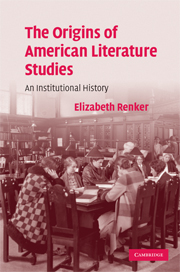Book contents
- Frontmatter
- Contents
- Acknowledgments
- Introduction
- Chapter 1 The birth of the Ph.D.: The Johns Hopkins research model
- Chapter 2 Seminary wars: female teachers and the seminary model at Mount Holyoke
- Chapter 3 Higher education for African Americans: competing models at Wilberforce University
- Chapter 4 Literary value and the land-grant model: The Ohio State University
- Conclusion: the end of the curriculum
- Notes
- Bibliography
- Archives consulted
- Index
Chapter 2 - Seminary wars: female teachers and the seminary model at Mount Holyoke
Published online by Cambridge University Press: 22 September 2009
- Frontmatter
- Contents
- Acknowledgments
- Introduction
- Chapter 1 The birth of the Ph.D.: The Johns Hopkins research model
- Chapter 2 Seminary wars: female teachers and the seminary model at Mount Holyoke
- Chapter 3 Higher education for African Americans: competing models at Wilberforce University
- Chapter 4 Literary value and the land-grant model: The Ohio State University
- Conclusion: the end of the curriculum
- Notes
- Bibliography
- Archives consulted
- Index
Summary
As the research university with its Ph.D. credential spread throughout American higher education, it coexisted, often uneasily, with competing educational models. Of course, it was only from a later historical vantage that the outcome of these contests would become clear. No one could have known in 1876 that within 15 years the research model would thoroughly redefine American higher education. During this era of flux, one intense form of institutional competition transpired between the new research university and the traditional old-style female seminary, a common form of the school in the United States before the Civil War. The female seminary trained young women to become teachers, mostly for lower schools but also for the female seminaries themselves. Female seminary teachers taught a prescribed curriculum of the kind they had themselves learned, acting as conduits of textbook knowledge for students who would go on, as teachers, to replicate the same pedagogy. This model of the teacher faced new and previously unimaginable pressures in the last decades of the nineteenth century. By that time, Johns Hopkins was redefining college teachers as credentialized experts and putting forth its new style of “seminary” pedagogy. The purpose of the Hopkins “seminary” was of course not to produce lower-level teachers who would transmit standard textbook knowledge, but rigorously to train new generations of knowledge experts who would produce the next wave of original research. In the postbellum battle between these opposed seminary models, the old-style seminary would become one of the institutional casualties of the era.
- Type
- Chapter
- Information
- The Origins of American Literature StudiesAn Institutional History, pp. 40 - 63Publisher: Cambridge University PressPrint publication year: 2007



